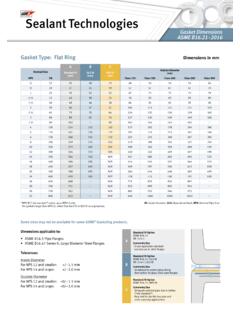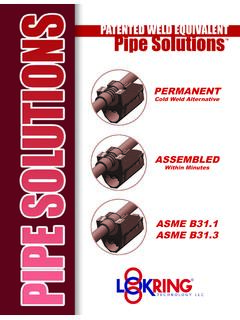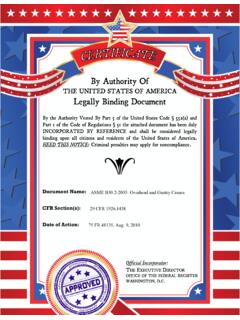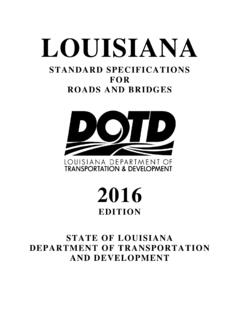Transcription of Below-the-Hook Lifting Devices
1 AN american NATIONAL STANDARDASME (Revision of asme ) Below-the-Hook Lifting DevicesSafety Standard for Cableways, Cranes, Derricks, Hoist, hooks , Jacks, and (Revision of asme ) below -the-HookLifting DevicesSafety Standard for Cableways,Cranes, Derricks, Hoists, hooks ,Jacks, and SlingsAN american NATIONAL STANDARDTwo Park Avenue New York, NY 10016 of Issuance: January 15, 2014 The next edition of this Standard is scheduled for publication in 2016. This Standard will becomeeffective 1 year after the Date of issues written replies to inquiries concerning interpretations of technical aspects of thisStandard.
2 Interpretations are published on the asme Web site under the Committee Pages as they are issued, and will also be published within the next edition ofthe to codes and standards may be posted on the asme Web site under the Committee Pages toprovide corrections to incorrectly published items, or to correct typographical or grammatical errorsin codes and standards. Such errata shall be used on the date Committee Pages can be found at There is an option available toautomatically receive an e-mail notification when errata are posted to a particular code or option can be found on the appropriate Committee Page after selecting Errata in the PublicationInformation is the registered trademark of The american society of mechanical code or standard was developed under procedures accredited as meeting the criteria for american NationalStandards.
3 The Standards Committee that approved the code or standard was balanced to assure that individuals fromcompetent and concerned interests have had an opportunity to participate. The proposed code or standard was madeavailable for public review and comment that provides an opportunity for additional public input from industry, academia,regulatory agencies, and the does not approve, rate, or endorse any item, construction, proprietary device, or does not take any position with respect to the validity of any patent rights asserted in connection with anyitems mentioned in this document.
4 And does not undertake to insure anyone utilizing a standard against liability forinfringement of any applicable letters patent, nor assume any such liability. Users of a code or standard are expresslyadvised that determination of the validity of any such patent rights, and the risk of infringement of such rights, isentirely their own by federal agency representative(s) or person(s) affiliated with industry is not to be interpreted asgovernment or industry endorsement of this code or accepts responsibility for only those interpretations of this document issued in accordance with the establishedASME procedures and policies, which precludes the issuance of interpretations by part of this document may be reproduced in any form,in an electronic retrieval system or otherwise,without the prior written permission of the american society of mechanical EngineersTwo Park Avenue, New York.
5 NY 10016-5990 Copyright 2014 byTHE american society OF mechanical ENGINEERSAll rights reservedPrinted in Standard of 20-0 Scope, Definitions, Personnel Competence, Translations and ReferencesSection Scope of asme Definitions Definitions for Chapter Definitions for Chapter Definitions for Chapter Definitions for Chapter Definitions for Chapter Personnel References to Other Codes and 20-1 Structural and mechanical Lifting DevicesSection Marking, Construction, and Inspection, Testing, and Instruction 20-2 Vacuum Lifting DevicesSection Marking, Construction, and Inspection, Testing, and Instruction 20-3 Close Proximity Operated Lifting MagnetsSection Marking, Construction, and Inspection, Testing, and Instruction 20-4 Remotely Operated Lifting MagnetsSection Marking, Construction, and Inspection, Testing.
6 And Instruction 20-5 Scrap and Material-Handling GrapplesSection Marking, Construction, and Inspection, Testing, and Instruction Lifters: Friction-Type Lifters: Indentation-Type and Material-Handling b l Inspection for Below-the-Hook Lifting american National Standard, Safety Standard for Cableways, Cranes, Derricks, Hoists, hooks , Jacks, and Slings, has been developed under the procedures accredited by the AmericanNational Standards Institute (ANSI). This Standard had its beginning in December 1916 whenan eight-page Code of Safety Standards for Cranes, prepared by an asme Committee on theProtection of Industrial Workers, was presented at the annual meeting of the and discussions regarding safety on cranes, derricks, and hoists were held from 1920to 1925, involving the asme Safety Code Correlating Committee, the Association of Iron andSteel Electrical Engineers, the american Museum of Safety, the american Engineering StandardsCommittee (AESC)
7 (later changed to american Standards Association (ASA), then to the UnitedStates of America Standards Institute (USASI), and finally to ANSI), Department of Labor State of New Jersey, Department of Labor and Industry State of Pennsylvania, and theLocomotive Crane Manufacturers Association. On June 11, 1925, AESC approved the ASMES afety Code Correlating Committee s recommendation and authorized the project with Department of the Navy, Bureau of Yards and Docks, and asme as March 1926, invitations were issued to 50 organizations to appoint representatives to aSectional Committee.
8 The call for organization of this Sectional Committee was sent outOctober 2, 1926, and the committee organized November 4, 1926, with 57 members representing29 national organizations. Commencing June 1, 1927, and using the eight-page code publishedby asme in 1916 as a basis, the Sectional Committee developed the Safety Code for Cranes,Derricks, and Hoists. The early drafts of this safety code included requirements for Jacks, but,due to inputs and comments on those drafts, the Sectional Committee decided in 1938 to makethe requirements for Jacks a separate code.
9 In January 1943, ASA was publishedaddressing a multitude of equipment types and in August 1943, ASA was publishedjust addressing Jacks. Both documents were reaffirmed in 1952 and widely accepted as to changes in design, advancement in techniques, and general interest of labor and industryin safety, the Sectional Committee, under the joint sponsorship of asme and the Bureau of Yardsand Docks (now the Naval Facilities Engineering Command) was reorganized on January 31, 1962,with 39 members representing 27 national organizations.
10 The new committee changed the formatof ASA so that the multitude of equipment types it addressed could be published inseparate volumes that could completely cover the construction, installation, inspection, testing,maintenance, and operation of each type of equipment that was included in the scope of ASA format change resulted in the initial publication of , , , and designated as Revisions of with the remainder of the B30 volumes being publishedas totally new volumes. ASA changed its name to USASI in 1966 and to ANSI in 1969, whichresulted in B30 volumes from 1943 to 1968 being designated as either ASA B30, USAS B30, orANSI B30, depending on their date of 1982, the Committee was reorganized as an Accredited Organization Committee, operatingunder procedures developed by asme and accredited by ANSI.







